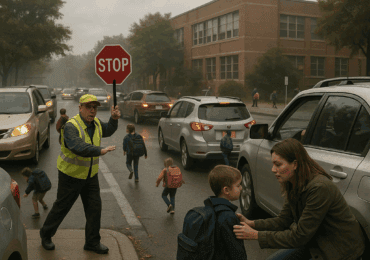Parents trust that school zones are designed with safety in mind, but the reality at drop-off time often says otherwise. With cars jockeying for space and children darting between vehicles, accidents are more common than they should be. In cases where harm occurs, a child accident attorney may help uncover whether preventable dangers were ignored.
Common Safety Risks for Young Pedestrians
Distracted Drivers
The hectic nature of school drop-off zones often leads to distracted driving. Parents rushing to get their children to school on time may be preoccupied with last-minute instructions or searching for parking spots. This divided attention increases the risk of overlooking young pedestrians, especially those darting between vehicles or crossing outside designated areas.
Poor Visibility
Crowded drop-off zones create numerous blind spots for both drivers and pedestrians. Large vehicles like SUVs and vans can obscure smaller children from view. Additionally, early morning darkness or inclement weather conditions further reduce visibility, making it challenging for drivers to spot young pedestrians in time to react.
Unpredictable Child Behavior
Young children often lack the cognitive skills to judge traffic situations accurately. They may unexpectedly dash across the street, fail to look both ways before crossing, or assume drivers can see them. This unpredictability, combined with their smaller stature, makes children particularly vulnerable in busy drop-off zones.
Inadequate Infrastructure
Many school zones lack proper infrastructure to safely accommodate the high volume of vehicles and pedestrians during peak hours. Insufficient crosswalks, poorly marked pedestrian paths, or inadequate lighting can create confusion and increase the risk of accidents. Without clear traffic flow patterns, drivers and pedestrians may make dangerous assumptions about right-of-way.
Why Drop-Off Zone Design Matters for Student Safety
The Crucial Role of Thoughtful Planning
The design of school drop-off zones plays a pivotal role in safeguarding our children. Well-planned zones create a buffer between vehicular traffic and pedestrian areas, significantly reducing the risk of accidents. By incorporating clear signage, designated crossing points, and ample space for vehicles to maneuver, these zones can dramatically enhance student safety during the busiest times of the school day.
Mitigating Traffic Congestion and Chaos
Poorly designed drop-off areas often lead to traffic bottlenecks, impatient drivers, and confused pedestrians—a recipe for disaster. A thoughtfully engineered zone, however, can efficiently manage traffic flow, minimizing congestion and the temptation for drivers to make risky maneuvers. This orderly environment allows students to navigate the area more confidently and securely.
Promoting Safe Behaviors Through Design
The layout of a drop-off zone can inherently encourage safer behaviors from drivers and students. Wide sidewalks, clearly marked crosswalks, and strategically placed barriers guide pedestrians along the safest routes. Similarly, well-defined lanes and drop-off points help drivers maintain orderly conduct. By fostering these positive habits through design, schools can create a culture of safety that extends beyond the immediate vicinity of the drop-off zone.
Strategies to Improve Safety in School Drop-Off Zones
Redesign Traffic Flow
Consider redesigning the traffic flow to enhance safety in school drop-off zones. Implement one-way systems to reduce congestion and minimize the risk of collisions. Create designated areas for buses, cars, and pedestrians, clearly marked with bright paint and signage. Install speed bumps or raised crosswalks to slow vehicles and prioritize pedestrian safety.
Educate and Enforce
Develop comprehensive education programs for parents, students, and staff about proper drop-off procedures. Distribute informational materials and host workshops to reinforce safe practices. Enlist the help of crossing guards and school staff to monitor the drop-off zone during peak hours. Consider implementing a penalty system for those who repeatedly violate safety rules.
Utilize Technology
Leverage technology to improve safety. Install automated gates or barriers to control vehicle access during specific times. Use digital signage to display real-time information about traffic conditions and safety reminders. Implement a mobile app for parents to coordinate arrivals and departures, reducing congestion and wait times.
How Parents Can Help Protect Young Pedestrians
Model Safe Pedestrian Behavior
As a parent, you play a crucial role in safeguarding your children around school drop-off zones. Start by consistently demonstrating proper pedestrian safety habits. Always use designated crosswalks, obey traffic signals, and look both ways before crossing. Your actions speak louder than words, so make safety a visible priority.
Educate Your Children on Traffic Rules
Teach your kids about traffic signs, signals, and road safety. Explain the importance of staying alert and avoiding distractions like smartphones while walking. Emphasize making eye contact with drivers before crossing, even at marked crosswalks. Regular discussions about road safety can help reinforce these critical habits.
Advocate for Improved School Zone Safety
Get involved in your school’s safety initiatives. Attend PTA meetings and voice concerns about potential hazards in drop-off areas. Suggest improvements like better signage, increased crossing guard presence, or redesigned traffic flow. Your active participation can lead to meaningful changes that benefit all students.
Final Thoughts
When schools or drivers fail to prioritize safety, the consequences fall hardest on children. A skilled child accident attorney can guide families through the legal aftermath while advocating for change. Safer school zones start with recognizing and addressing the risks.
